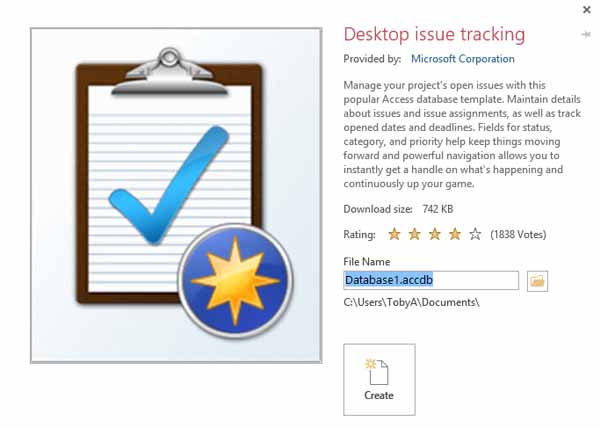How to Create a Database in Microsoft Access 2013
Synopsis: In this article we look at the options for creating a new database in Access 2013.
In earlier versions of Microsoft Access, a database has usually meant a desktop database. This is a database comprising data structures and user interface components that enable one or more users to maintain data. In the most common scenario a single user has a single file containing all of the components of the database and the user opens this file on a single PC.
Sometimes the data components and the user interface components have been separated so that several users can have their own copies of the user interface components but can share the data components with other users. Typically this has been done by placing the data on a network server or network storage device and installing the required user interface components on each user’s PC.
In Access 2013 both of these scenarios are still available, but it is also possible to create a web app, whereby the database is hosted on a Microsoft SharePoint site. If you don’t have access to SharePoint, you can use SharePoint Access Services via Office 365.
Do you need to learn Access 2013? Get our 9-hour of Microsoft Access 2013 training – click here.
Two of the main advantages associated with using a web app are that the data can be maintained from any location with Internet access – subject to permissions and security, of course – and that users only need a supported web browser to do the data maintenance.
Whether you want to create a desktop database or a web app, a good starting point is the Access 2013 start screen. If you click on the first tile Custom web app you will see this dialog.


Access 2013 provides a default name for the web app.
You are then presented with a list of available locations. Exactly which locations you are offered will depend on the account under which you are running Access 2013 and the availability of SharePoint sites to you. Here I have been offered either the site for my personal apps or my Team Site that is available via Office 365.
Below the list of available locations is the URL for the selected one.
When you have made sure that my new web app has a meaningful name and selected the location for it, click on Create to create the web app. Once it’s been created you can start to develop it further by adding tables, data, etc.
As an alternative to creating a web app you can create a desktop database. To do this, either select Blank desktop database from the start screen or click the arrow to the right of the Custom web app dialog above. In fact, repeatedly clicking that arrow steps you through the available options for new web apps and databases.
The dialog for a new desktop database looks like this:


Access 2013 has assigned the default location and a default name for the database file, including the standard accdb extension. Click on Create to create the desktop database.
In general, each tile on the start screen represents a database template. The ones that are used to create desktop databases have the word Desktop in their names and a background picture of a sheet of paper with a folded corner, whilst the others are used to create web apps.
If you select one of the tiles for a desktop database you will usually see a description of the purpose of the database and a rating based on feedback from users.


When you select a tile for a web app, you will often also see an image of part of the web app as it appears in a web browser.


Note that there additional templates available online. You can try to find something for your specific needs using the Search facility on the Access 2013 start screen.


